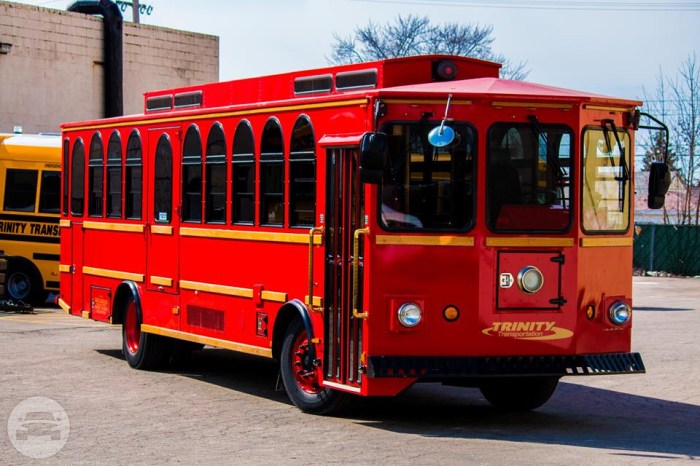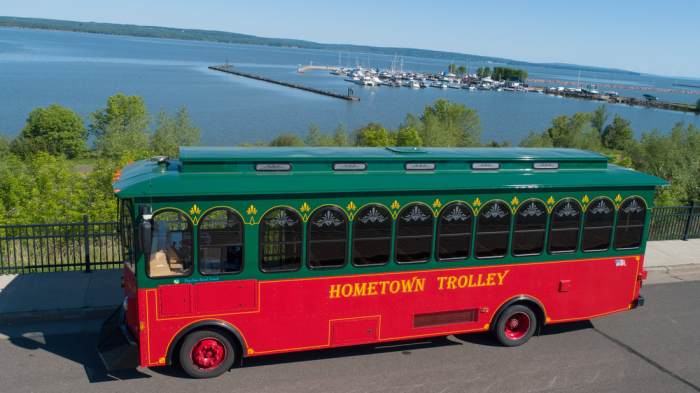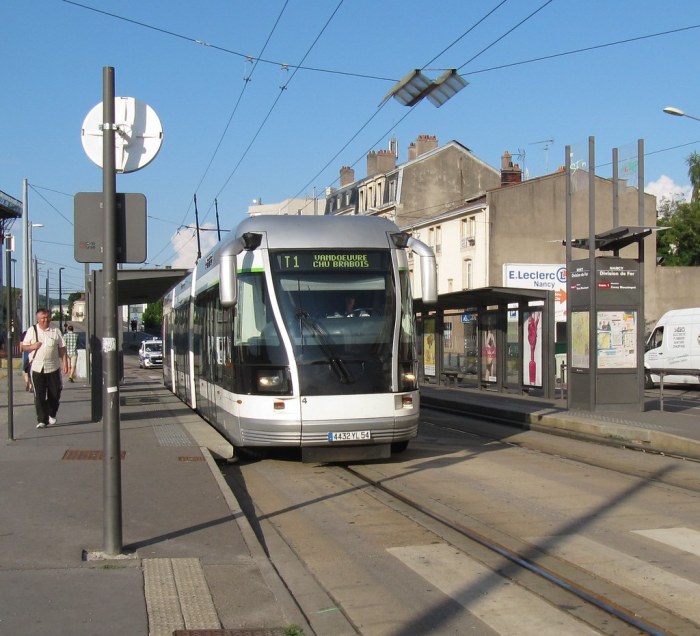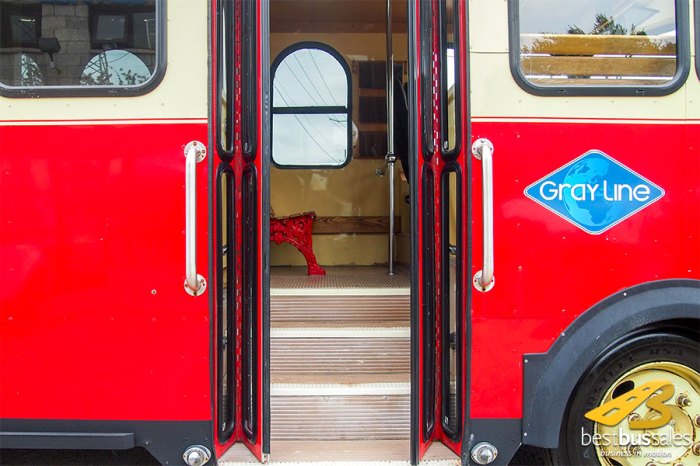Trolley busways can be used outdoors, offering a clean, efficient, and cost-effective mode of transportation. These systems provide numerous advantages over traditional diesel buses, including reduced emissions, lower operating costs, and improved passenger comfort. This article explores the benefits, design considerations, maintenance, and environmental impact of outdoor trolley busways, showcasing their potential to revolutionize urban transportation.
Outdoor trolley busways have been successfully implemented in cities worldwide, demonstrating their reliability and effectiveness. They offer a flexible and adaptable solution for various transportation needs, ranging from high-capacity commuter routes to smaller neighborhood circulators. As cities strive to reduce their carbon footprint and improve air quality, trolley busways emerge as a promising solution.
Benefits of Outdoor Trolley Busways
Outdoor trolley busways offer several advantages, making them a suitable transportation solution in various urban environments. These benefits include:
- Reduced Emissions:Trolley busways powered by electricity produce zero tailpipe emissions, contributing to improved air quality and reducing greenhouse gas emissions.
- Energy Efficiency:Electric trolley buses are more energy-efficient than diesel or gasoline-powered buses, resulting in lower operating costs.
- Quieter Operation:Electric trolley buses generate less noise compared to traditional buses, reducing noise pollution in urban areas.
- Reliability and Capacity:Trolley busways provide a reliable and high-capacity transportation system, with dedicated lanes and overhead power supply ensuring consistent operation.
- Cost-Effectiveness:While the initial investment in trolley busways may be higher than traditional bus systems, their long-term operating costs are often lower due to reduced fuel and maintenance expenses.
Successful Outdoor Trolley Busway Implementations
Several cities worldwide have successfully implemented outdoor trolley busways. Notable examples include:
- San Francisco, California, USA:The San Francisco Municipal Railway (MUNI) operates one of the largest trolley bus systems in the world, with over 200 trolley buses serving various routes throughout the city.
- Seattle, Washington, USA:The Seattle Trolleybus System has been in operation since 1940 and currently operates over 150 trolley buses on several routes.
- Bern, Switzerland:The Bern trolleybus system is one of the oldest and most extensive in Europe, with over 100 trolley buses serving a network of routes.
- Shanghai, China:Shanghai has the world’s largest trolley bus fleet, with over 1,800 trolley buses operating on a network of dedicated busways.
Design Considerations for Outdoor Trolley Busways

The design of outdoor trolley busways requires careful consideration to ensure electrical safety, weatherproofing, and aesthetics.
Electrical Safety Measures
Outdoor trolley busways must comply with strict electrical safety standards to prevent accidents. These measures include:
- Proper grounding to minimize the risk of electrical shocks.
- Adequate insulation to prevent current leakage and short circuits.
- Protective enclosures to shield conductors from accidental contact.
Weatherproofing
Outdoor trolley busways must withstand harsh weather conditions, including rain, snow, and extreme temperatures. This requires:
- Durable materials that can resist corrosion and UV radiation.
- Watertight seals to prevent moisture ingress.
- Temperature-resistant components that can operate reliably in a wide range of temperatures.
Aesthetics
While electrical safety and weatherproofing are paramount, the aesthetics of outdoor trolley busways should also be considered. This includes:
- Visually appealing designs that complement the surrounding environment.
- Colors and textures that harmonize with the architecture and landscape.
- Discreet placement to minimize visual impact.
Maintenance and Operation of Outdoor Trolley Busways

Outdoor trolley busways require regular maintenance and operation procedures to ensure safe and efficient operation. These procedures include regular inspections, cleaning, and repairs.
Unique challenges associated with outdoor operation include exposure to weather elements such as rain, snow, and ice. These elements can cause corrosion, icing, and other problems that require additional maintenance and operational considerations.
Inspection and Cleaning
Regular inspections are essential to identify any potential problems with the trolley busway system. Inspections should be conducted by qualified personnel and should include a visual examination of the busway, supports, and insulators. Any damage or defects should be repaired promptly.
Cleaning is also important to remove dirt, debris, and other contaminants that can accumulate on the busway. Cleaning should be done using a soft brush or cloth and a mild detergent. Avoid using harsh chemicals or abrasive cleaners.
Repairs
Repairs to the trolley busway system should be made by qualified personnel. Repairs may include replacing damaged components, tightening loose connections, or repairing insulation. It is important to use the correct materials and procedures when making repairs.
Safety Considerations
Safety is a top priority when working on or around outdoor trolley busways. Always follow proper safety procedures, including wearing appropriate personal protective equipment (PPE) and using caution when working near energized equipment.
Environmental Impact of Outdoor Trolley Busways

Outdoor trolley busways offer several environmental benefits compared to other transportation options.
Reduced Air Pollution
Trolley buses are powered by electricity, eliminating tailpipe emissions and reducing air pollution. Electric motors are more efficient than internal combustion engines, producing less noise and heat.
Lower Greenhouse Gas Emissions
Electricity for trolley buses can be generated from renewable sources like solar and wind, reducing greenhouse gas emissions. Compared to diesel buses, trolley buses can reduce carbon dioxide emissions by up to 90%.
Improved Air Quality
By reducing air pollution and greenhouse gas emissions, trolley busways contribute to improved air quality in urban areas. This can lead to reduced respiratory illnesses, improved cardiovascular health, and a more pleasant living environment.
Noise Reduction
Electric motors in trolley buses are quieter than diesel engines, reducing noise pollution in urban areas. This can improve the quality of life for residents and create a more peaceful environment.
Energy Efficiency
Trolley buses are more energy-efficient than diesel buses, as they do not require fuel to operate. The use of regenerative braking systems further improves energy efficiency by capturing energy during braking and returning it to the grid.
Comparison to Other Transportation Options
Compared to other transportation options, trolley busways have a lower environmental impact:
- Diesel buses:Trolley buses produce significantly fewer emissions and are more energy-efficient.
- Gasoline-powered vehicles:Trolley buses eliminate tailpipe emissions and have a lower carbon footprint.
- Light rail:While light rail systems are also electric, they require more infrastructure and are typically more expensive to implement.
- Electric buses:Battery-powered electric buses have similar environmental benefits to trolley buses but may have limited range and require charging infrastructure.
Case Studies of Outdoor Trolley Busways

Outdoor trolley busways have been successfully implemented in various cities worldwide, providing efficient and environmentally friendly public transportation. This section presents detailed case studies of notable outdoor trolley busway projects, highlighting their scope, challenges, and performance outcomes.
Seattle Trolley Bus System, Trolley busways can be used outdoors
The Seattle Trolley Bus System, established in 1940, is one of the oldest and most extensive trolley bus networks in the United States. It operates a fleet of over 150 trolley buses on 15 routes, covering a total of 120 miles (193 kilometers).
The system has undergone several upgrades over the years, including the installation of overhead wires, substations, and new trolley buses. These improvements have resulted in increased reliability, efficiency, and ridership.
Key performance indicators for the Seattle Trolley Bus System include:
- Average weekday ridership: 65,000
- On-time performance: 95%
- Average speed: 10 mph (16 km/h)
Vancouver Trolley Bus System
The Vancouver Trolley Bus System, launched in 1947, operates 29 trolley bus routes with a fleet of over 200 vehicles. It is the third-largest trolley bus system in North America.
The system has faced challenges, including traffic congestion and overhead wire maintenance. However, it has remained a popular and efficient mode of public transportation due to its zero-emission operation and reliability.
Key performance indicators for the Vancouver Trolley Bus System include:
- Average weekday ridership: 100,000
- On-time performance: 97%
- Average speed: 12 mph (19 km/h)
San Francisco Trolley Bus System
The San Francisco Trolley Bus System, established in 1935, operates 10 trolley bus routes with a fleet of over 100 vehicles. It is the second-oldest trolley bus system in the United States.
The system has undergone several modernization projects, including the installation of new overhead wires, substations, and trolley buses. These upgrades have improved the system’s reliability and efficiency.
Key performance indicators for the San Francisco Trolley Bus System include:
- Average weekday ridership: 45,000
- On-time performance: 96%
- Average speed: 11 mph (18 km/h)
Future Trends in Outdoor Trolley Busways
Outdoor trolley busways are poised for significant advancements in design and operation. Emerging technologies and innovations are expected to enhance their efficiency, reliability, and sustainability.
One key trend is the adoption of lightweight materials and composite structures. These materials offer improved strength-to-weight ratios, enabling longer spans and reduced support structures. This results in cost savings and increased flexibility in route planning.
Advanced Power Distribution Systems
Improvements in power distribution systems are also anticipated. The integration of solid-state switching devices and digital control systems will enhance power flow management and reduce energy losses. This will lead to improved reliability and lower operating costs.
Automated Vehicle Operation
Automation is another emerging trend in outdoor trolley busways. The implementation of automated vehicle operation systems will reduce labor costs and improve safety. Advanced sensors and communication technologies will enable precise vehicle positioning and collision avoidance.
Integration with Renewable Energy Sources
Outdoor trolley busways are well-suited for integration with renewable energy sources, such as solar and wind power. By connecting to these sources, trolley busways can reduce their reliance on fossil fuels and contribute to a more sustainable transportation system.
Potential Future Applications
Beyond traditional urban transportation, outdoor trolley busways have potential applications in various settings, including:
- Airport shuttle services
- Campus transportation systems
- Industrial parks
- Special event venues
These applications offer opportunities for tailored design and innovative solutions to meet specific transportation needs.
Quick FAQs: Trolley Busways Can Be Used Outdoors
Are outdoor trolley busways more expensive than diesel buses?
While the initial infrastructure costs for trolley busways can be higher than diesel buses, their long-term operating costs are significantly lower due to reduced fuel consumption and maintenance expenses.
What are the environmental benefits of outdoor trolley busways?
Trolley busways powered by renewable energy sources, such as wind or solar, produce zero emissions, contributing to improved air quality and reduced greenhouse gas emissions.
Are outdoor trolley busways reliable in all weather conditions?
Modern trolley busways are designed to withstand various weather conditions, including extreme temperatures, rain, and snow. They incorporate weatherproofing measures to ensure safe and reliable operation.
